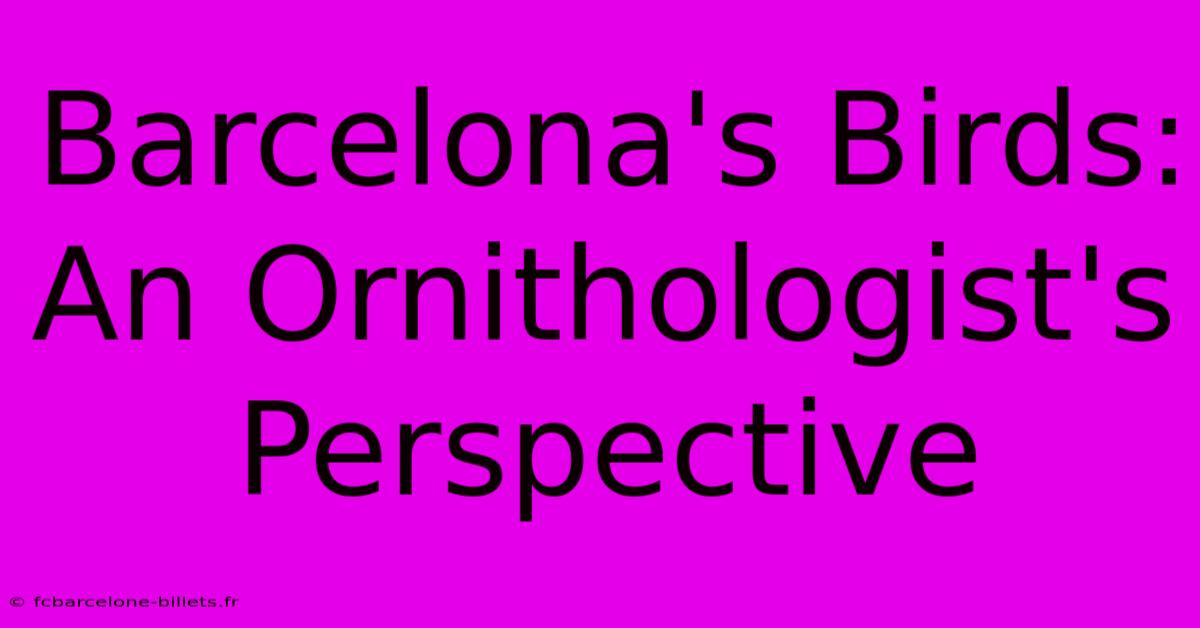Barcelona's Birds: An Ornithologist's Perspective

Table of Contents
Barcelona's Birds: An Ornithologist's Perspective
Barcelona, a vibrant coastal metropolis, offers a surprisingly rich tapestry of avian life. Beyond the architectural marvels and bustling city streets, a keen observer can discover a diverse array of bird species, reflecting the city's unique blend of urban and natural environments. This article explores Barcelona's birdlife from an ornithologist's perspective, highlighting key species, habitats, and the challenges facing these feathered inhabitants.
A Diverse Avian Community
Barcelona's bird population is a fascinating mix of resident species, migratory visitors, and opportunistic urban adapters. The city's location on the Mediterranean coast, proximity to the Pyrenees Mountains, and the presence of various green spaces create a diverse habitat mosaic.
Common Residents:
- House Sparrow (Passer domesticus): A ubiquitous presence in urban areas worldwide, the House Sparrow thrives in Barcelona's built environment, making use of human-altered habitats.
- European Robin (Erithacus rubecula): This cheerful, reddish-breasted bird is a common sight in parks and gardens, its melodious song adding to the city's soundscape.
- Common Blackbird (Turdus merula): Another familiar resident, the Common Blackbird's distinctive song is often heard in the quieter corners of Barcelona's green spaces.
- Collared Dove (Streptopelia decaocto): With its soft cooing call, the Collared Dove is a common sight in parks, gardens, and even city centers.
Migratory Visitors:
Barcelona acts as an important stopover point for many migratory birds traveling along the Mediterranean flyway. During spring and autumn, the skies above Barcelona are alive with activity as countless birds journey between their breeding and wintering grounds. These visitors include:
- Swallows and Martins: Several species of swallows and martins, such as the Barn Swallow (Hirundo rustica) and the Common Swift (Apus apus), pass through Barcelona during their migrations. Their aerial acrobatics are a sight to behold.
- Warblers: Various warbler species use Barcelona's green spaces as temporary refuges during their long journeys. These small, often brightly colored birds are a delight for birdwatchers.
- Herons and other Waders: The nearby wetlands and coastal areas attract wading birds like herons, egrets, and other waterbirds during migration.
Urban Adapters:
Some bird species have successfully adapted to the challenges of urban living, finding food and shelter within the city's confines. These resourceful birds include:
- Feral Pigeons (Columba livia domestica): Though often considered a nuisance, feral pigeons are a testament to the adaptability of birds in urban environments.
- Black-headed Gulls (Chroicocephalus ridibundus): Often seen scavenging in city parks and near the coast, these gulls are opportunistic feeders, taking advantage of human-provided food sources.
Key Habitats within Barcelona:
Several key habitats within Barcelona support its diverse avian population:
- Parc de la Ciutadella: This large urban park provides a haven for a variety of birds, including several resident and migratory species.
- Montjuïc Hill: The diverse vegetation and elevation changes on Montjuïc offer habitats for a range of bird species, including some more specialized birds.
- Coastal Areas: Barcelona's coastline, including beaches and nearby wetlands, supports coastal bird species.
- Gardens and Parks: The numerous smaller parks and gardens scattered throughout the city provide vital habitats for urban bird populations.
Conservation Challenges:
Despite its relatively rich birdlife, Barcelona's avian community faces several challenges:
- Habitat Loss: Urban sprawl and development continue to encroach on natural habitats, reducing the space available for birds.
- Pollution: Air and water pollution can negatively impact bird health and survival.
- Climate Change: Changing climate patterns may alter migration patterns and affect the availability of food resources for birds.
- Human Disturbance: Noise and human activity in parks and other green spaces can stress birds and disrupt their breeding cycles.
Conclusion:
Barcelona's birds offer a captivating glimpse into the complex interplay between urban development and natural ecosystems. By understanding the challenges facing these avian inhabitants, we can work towards creating a more bird-friendly city, ensuring that future generations can appreciate the rich biodiversity that exists within this vibrant metropolis. Continued research and conservation efforts are crucial to protecting Barcelona's valuable avian heritage. Citizen science initiatives, such as birdwatching and reporting sightings, can play a significant role in monitoring bird populations and informing conservation strategies. By working together, we can help ensure the long-term survival of Barcelona's remarkable birds.

Thank you for visiting our website wich cover about Barcelona's Birds: An Ornithologist's Perspective. We hope the information provided has been useful to you. Feel free to contact us if you have any questions or need further assistance. See you next time and dont miss to bookmark.
Featured Posts
-
2011 12 Barcelona Kit A Piece Of Football History
Apr 05, 2025
-
Meet Your Friends Barcelonas Social Scene
Apr 05, 2025
-
Cava Tapas And Sunset Barcelona Magic
Apr 05, 2025
-
Barcelona Hammam Your Private Oasis
Apr 05, 2025
-
Sustainable Birdwatching In Barcelona
Apr 05, 2025
